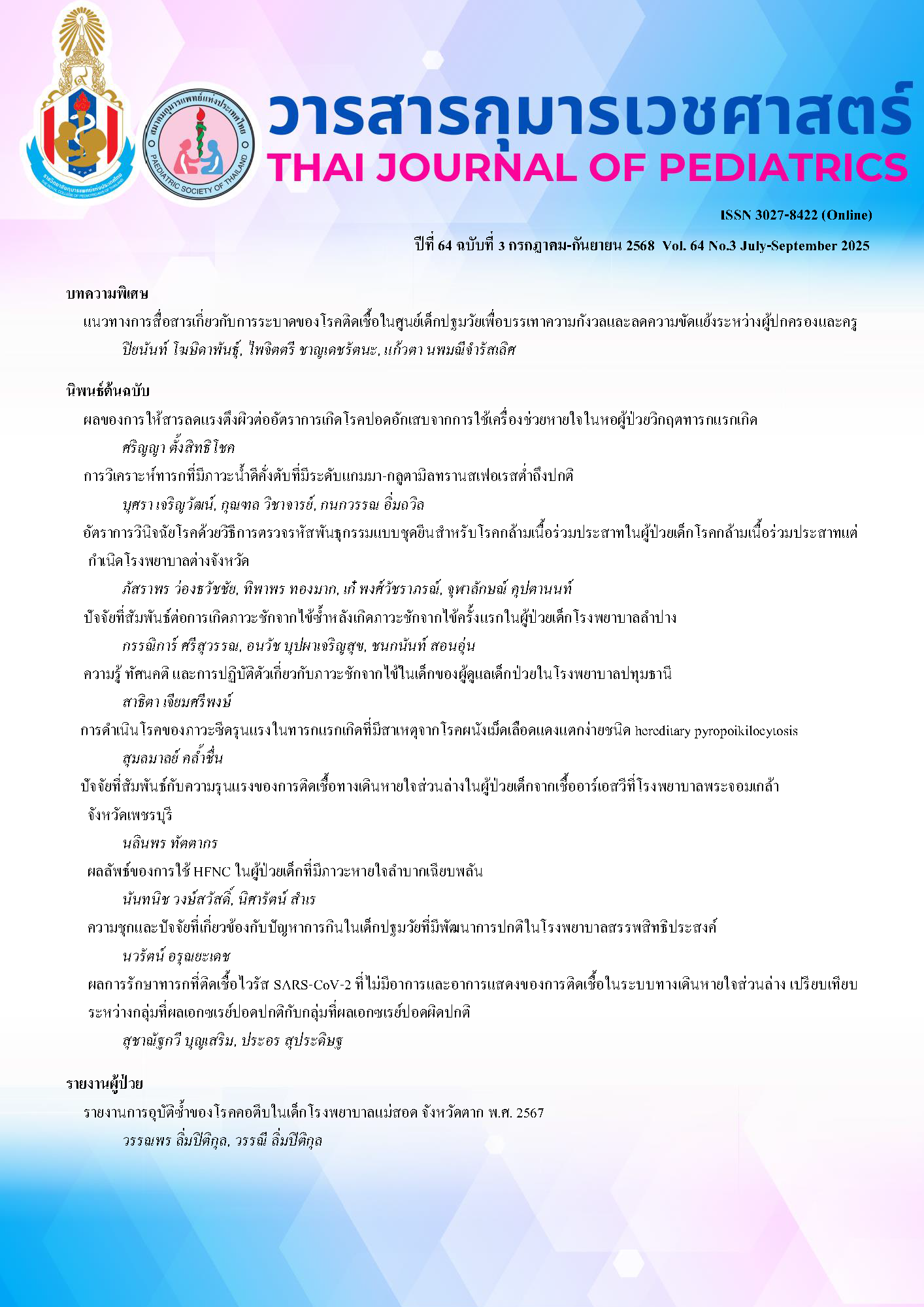แนวทางการสื่อสารเกี่ยวกับการระบาดของโรคติดเชื้อในศูนย์เด็กปฐมวัยเพื่อบรรเทาความกังวล และลดความขัดแย้งระหว่างผู้ปกครองและครู
คำสำคัญ:
การสื่อสารลดความขัดแย้ง, โรคติดเชื้อ, เทคนิคการสื่อสาร, การควบคุมการระบาดบทคัดย่อ
ความก้าวหน้าทางเทคโนโลยีทางการแพทย์ทำให้สามารถระบุเชื้อก่อโรคได้อย่างแม่นยำ ส่งผลให้ประชาชนตระหนักถึงความสำคัญของโรคติดเชื้อมากขึ้น โดยเฉพาะหลังการระบาดของโควิด-19 การรับรู้เพียงว่าการติดเชื้อเกิดจากไวรัสไม่เพียงพออีกต่อไป ประชาชนต้องการข้อมูลที่ชัดเจนเกี่ยวกับชนิดของเชื้อ ความรุนแรงของโรคและแนวทางปฏิบัติที่เหมาะสม บทความนี้นำเสนอแนวทางและเทคนิคการให้กุมารแพทย์เพื่อจะสามารถนำไปสอนหรือสื่อสารระหว่างครูกับผู้ปกครองเพื่อบรรเทาความวิตกกังวล ลดความตื่นตระหนก และป้องกันความขัดแย้ง ประกอบด้วยการสร้างความไว้วางใจ (trust) การสื่อสารแบบสองทาง (two-way communication) บทสนทนา (the conversation) ศิลปะการฟัง (the art of listening) เทคนิคการส่งเสริมการสื่อสาร (techniques to facilitate communication) และการสื่อสารที่ไม่ใช้คำพูด (nonverbal communication) เทคนิคเหล่านี้สามารถเสริมสร้างความเข้าใจระหว่างครูและผู้ปกครอง ช่วยให้การสื่อสารเป็นไปอย่างราบรื่นและลดความขัดแย้งได้อย่างมีประสิทธิภาพ นอกจากการใช้เทคนิคการสื่อสารที่เหมาะสมแล้ว ครูควรมีความรู้เกี่ยวกับโรคติดเชื้อ โรคระบาด และแนวทางป้องกันการแพร่กระจายของโรค เพื่อให้สามารถถ่ายทอดข้อมูลได้อย่างถูกต้อง ชัดเจน และมั่นใจ
Downloads
เอกสารอ้างอิง
กรมควบคุมโรค, กองโรคติดต่อ. สถานการณ์โรคติดต่อในเด็กปี 2566: 5 โรคที่สำคัญ. นนทบุรี: กรมควบคุมโรค; 2566.
Lertsuphotvanit S, Kloimklinsuk A, Sanaprom J, Tongfak O, Ponsanong N. Guidelines for control and prevention of disease and health hazard for childcare teacher. Nonthaburi: Department of disease control (TH); 2023.
หลักการจัดการโรคติดเชื้อในโรงเรียนและศูนย์เด็กเล็ก. CIM Journal [Internet]. Available from: https://cimjournal.com/confer-update/chain-of-infection/ [cited 24 Feb 2025]
European centre for disease prevention and control. Guidelines for non-pharmaceutical interventions to reduce the impact of COVID-19 in the EU/EEA and the UK [Internet]. Stockholm: ECDC; 2020 [cited 2024 Nov 11]. Available from:https://www.ecdc.europa.eu/sites/default/files/documents/novel-coronavirus-guidelines-non-pharmaceutical-measures_0.pdf.
ราชวิทยาลัยกุมารแพทย์แห่งประเทศไทย. คำแนะนำโรคไอกรนสำหรับบุคลากรทางการแพทย์. 14 พฤศจิกายน 2567. Available from: https://pidst.or.th/A1472.html [cited 24 Feb 2025]
ราชวิทยาลัยกุมารแพทย์แห่งประเทศไทย. คำแนะนำโรคไอกรนสำหรับประชาชน. 14 พฤศจิกายน 2567. Available from: https://www.pidst.or.th/A1473.html [cited 24 Feb 2025]
Cauchemez S, Ferguson NM, Wachtel C, Tegnell A, Saour G, Duncan B, et al. Closure of schools during an influenza pandemic. Lancet Infect Dis. 2009;9:473-81.
Schneiders ML, Naemiratch B, Cheah PK, Cuman G, Poomchaichote T, Ruangkajorn S, et al. The impact of COVID-19 non-pharmaceutical interventions on the lived experiences of people living in Thailand, Malaysia, Italy and the United Kingdom: A cross-country qualitative study. PLoS One. 2022 ;17:e0262421.
Chase R, Valorose J. Exploring and developing communication strategies with parents [Internet]. Wilder Research; 2019 [cited 2024 Nov 11]. Available from: https://files.eric.ed.gov/fulltext/ED612478.pdf.
Marvel MK, Epstein RM, Flowers K, Beckman HB. Soliciting the patient's agenda: Have we improved? JAMA. 1999;281:283-7.
Texas children's hospital. Communicating with pediatric patients and their families: The texas children’s hospital guide for physicians, nurses, and other healthcare professionals. Houston (TX): Texas children's hospital. 2015 p. 17-21.
Heritage J, Robinson JD, Elliott MN, Beckett M, Wilkes M. Reducing patients' unmet concerns in primary care: the difference one word can make. J Gen Intern Med. 2007;22:1429-33.
Platt FW, Gordon GH. Field guide to the difficult patient interview. 2nd ed. Philadelphia: Lippincott Williams & Wilkins; 2004. Chapter 2, Listening p. 14-17.
Myerscough PR, Ford M. Talking with patients: keys to good communication. Oxford (UK): Oxford University Press; 1996 p. 16.
ดาวน์โหลด
เผยแพร่แล้ว
รูปแบบการอ้างอิง
ฉบับ
ประเภทบทความ
สัญญาอนุญาต
ลิขสิทธิ์ (c) 2025 ราชวิทยาลัยกุมารแพทย์แห่งประเทศไทย และ สมาคมกุมารแพทย์แห่งประเทศไทย

อนุญาตภายใต้เงื่อนไข Creative Commons Attribution-NonCommercial-NoDerivatives 4.0 International License.



